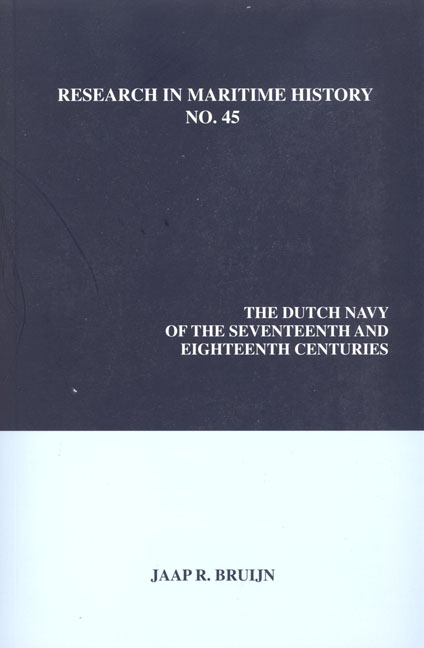Book contents
- Frontmatter
- Contents
- Illustrations
- Tables
- Series Editor's Foreword
- About the Author
- Introduction to the 2011 Edition
- Foreword
- Preface
- Introduction
- Map of the Dutch Republic
- Map of Dutch Naval Activity in European Waters
- Part One The “Old” Navy, Late 1500s-1652
- Part Two The “New” Navy, 1652-1713
- The “Old” Navy Out of Date
- John de Witt's New Navy
- An Era of Naval Campaigns against England and France and in the Baltic
- Changes in the Naval Administration
- De Ruyter and the Other Naval Officers
- Well-manned Ships
- Part Three A Second-Rate Navy, 1714-1795
- In Retrospect
- Bibliography
- Index
De Ruyter and the Other Naval Officers
from Part Two - The “New” Navy, 1652-1713
- Frontmatter
- Contents
- Illustrations
- Tables
- Series Editor's Foreword
- About the Author
- Introduction to the 2011 Edition
- Foreword
- Preface
- Introduction
- Map of the Dutch Republic
- Map of Dutch Naval Activity in European Waters
- Part One The “Old” Navy, Late 1500s-1652
- Part Two The “New” Navy, 1652-1713
- The “Old” Navy Out of Date
- John de Witt's New Navy
- An Era of Naval Campaigns against England and France and in the Baltic
- Changes in the Naval Administration
- De Ruyter and the Other Naval Officers
- Well-manned Ships
- Part Three A Second-Rate Navy, 1714-1795
- In Retrospect
- Bibliography
- Index
Summary
It is difficult to present a consistent picture of the naval officers of the first half of the seventeenth century. The term “corps” is hardly applicable to that group as it was then. Much changed after 1650. The navy, though split up into five admiralties, now was an independent organization, with its own ships, captains and other officers. The merchant masters and the commanders of the urban directieschepen disappeared during the 1650s. The captains and other officers were all selected by the admiralties themselves. They began to form a corps, fulfilling the requirements associated with that term - officers of all ranks with the technical skills necessary for handling a ship, especially in battle. At the very least, they were now able to give the appropriate orders. It was exceptional that a landlubber or an outsider was put in direct command of a fleet or even a single ship. Obdam, both an exception and a mistake, was the last of such. Almost all the post-1650 captains had spent at least a few years in junior ranks before they received their captain's commission.
Officers were required to have some specific knowledge and experience and to adhere to the printed instructions with regard to shipboard life and fighting that had been issued after the Second Anglo-Dutch War. Young nobleman Johan Willem baron van Rechteren, for instance, recorded all he learned on board during the years from 1690 through 1697 in his “memorial,” dealing with navigation, rigging, masts, ropes, signals and so on. Most officers remained in naval service for their entire careers; the navy was not an intermediate station for a totally different occupation, or a stepping stone to higher offices. Officers began to be considered a group of professionals with common experiences from naval campaigns and convoy trips. The “new” navy held a complete monopoly of force, for the wars against England and France had given ample evidence that only the navy could safeguard certain elements of the national interest.
The establishment of a standing navy, especially after its drastic expansion in the 1660s and the commitment to fit out squadrons and whole fleets, almost continuously compelled the naval administrators to ensure that they could rely on a qualified corps of officers. Ships were larger and often manned by four to six hundred seamen and soldiers. And more ships required more captains and flag officers.
- Type
- Chapter
- Information
- The Dutch Navy of the Seventeenth and Eighteenth Centuries , pp. 96 - 113Publisher: Liverpool University PressPrint publication year: 2011



